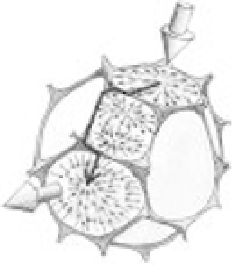Geoscience Reference
In-Depth Information
and the melt fraction (
) is a characteristic of
each individual system or situation. As shown
in Section 3.2.1, the
φ
relationship depends
on the dihedral angle in a texturally equili-
brated system, and as shown in Section 3.2.2,
under deviatoric stress, the contiguity tensor is
significantly influenced by any stress-induced
microstructural anisotropy. Such uncertainties
in contiguity cause large uncertainties in the
mechanical properties. For partially molten rock,
using the contiguity tensor as an internal state
variable, Takei and Holtzman (2009c) dealt with
the formulation of nonlinear viscosity caused by
stress-induced microstructural changes.
For partially molten rocks that are texturally
equilibrated, contiguity is determined as a
function of melt fraction and dihedral angle.
The relationship can be given approximately by
Equation (3.1) with
A
ϕ
-
φ
(a)
(b)
Fig. 3.7
Intuitive explanation for the singular behavior
of viscosity at
0 (Figure 3.6b-c). Even at
a very small melt fraction, an interconnected network
of melt works as a fast diffusion pathway that
significantly decreases viscosity due to the
short-circuit effect. After Takei and Holtzman (2009a).
Reproduced with permission of the American
Geophysical Union.
ϕ
→
1 and
φ
→
3 (Figure 3.1d). By sub-
stituting this specific relationship into the general
results of the contiguity model (Figure 3.6b), the
mechanical properties of texturally equilibrated
partially molten mantle rocks can be derived as
functions of the melt fraction (Figure 3.6c). In the
next section, I will discuss the properties of such
a texturally equilibrated system. The influence
of the stress in modifying the melt geometry, and
hence modifying the mechanical properties, is
discussed briefly in Section 3.7.
=
2
.
be removed. However, the critical melt fraction,
estimated under mantle conditions, is very small
(
10
−
8
for
10
−
4
for
η
sk
), indi-
cating that the singularity does exist in the prac-
tical sense, and that a very small amount of melt
(
φ
c
=
6
×
ξ
sk
,and
φ
c
=
>φ
c
) can significantly reduce the viscosities.
Elasticity does not have such a singularity,
making it difficult to detect a small amount
of melt from seismological observations. How-
ever, to consider the seismological detectability,
it is also necessary to assess the effect of small
amounts of melt on anelasticity. A preliminary
discussion is given in Section 3.7.2.
3.5 Properties of a Texturally Equilibrated
System
So far, the model of equilibrium melt geome-
try has been the best of the models available
for dealing with partially melted rocks in the
Earth's interior. Therefore, the mechanical prop-
erties of texturally equilibrated partially molten
rocks provide ''standard'' properties with which
the properties of other geometries can be un-
derstood and compared. Extensive experimen-
tal studies have been made on the elastic and
rheological properties of partially molten rocks
with nearly equilibrium textures (e.g., Murase &
Kushiro, 1979; Takei, 2000; Hirth & Kohlstedt,
2003; Faul & Jackson, 2007). In addition, the-
oretical models for these properties have been
3.4.5 Contiguity versus the fraction of melt
In the contiguity model, contiguity is intro-
duced independently of the melt fraction. The
fraction of melt does not explicitly influence
the mechanical properties, but it does have
an indirect influence through the effects on
contiguity. In order to relate the mechanical
properties to the melt fraction, it is necessary to
know the relationship between the melt fraction
and contiguity. Contiguity generally decreases
with increasing melt fraction. However, the
relationship in detail between the contiguity (
ϕ
)


